High Tension Suspension
By Anna Kitanaka
The coils of war
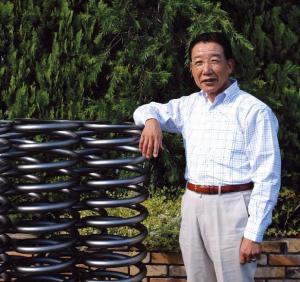 Yoshiki Watanabe and his hand crafted springs
Yoshiki Watanabe and his hand crafted springs
Although necessity may be the mother of invention, sadly, war is often the catalyst for contraptions to grow from crude devices to precise, efficient, mass produced instruments. From the aerosol can to the computer, the wars of last century had a major impact on their forward development. This trend is also true for some of our oldest inventions. Springs, for example, were invented from before recorded times and noncoiled springs were used in the bronze age for rudimentary appliances such as tweezers. Coiled springs are known to have been introduced in the 15th century and quickly became ubiquitous in their usage in everyday items such as clocks, bikes, beds and door hinges.
However, as a result of wars in the modern period, the spring has undergone rapid technical development—integral in the development of weapons such as the Lewis gun, a by-product of WWI. The usage of springs in the design proved enduringly reliable. Less obviously, the trampoline, which gets its bounce from coil springs and not the sheet of material stretched across it, has also proved a vital instrument during war. In WWII, it was used to train pilots and navigators,enabling them to have concentrated training on spatial awareness which had not been possible before. Trampolines are still being used to train astronauts in experiencing variable body positions in flight. Even the slinky toy, invented in 1945, has been used by the military. Whilst it is the Official State Toy of Pennsylvania in 2001 (thanks to its Pennsylvanian inventor), it was also used as a radio antennae during the Vietnam war. In fact, although the spring market is large and varied, geopolitics and the defense departments of the world still retain a significant influence on the nature of the market.
Recently, the US Department of Defense (DOD) issued a memorandum to update provisions of the Berry Amendment, a law that requires that certain goods purchased by the DOD are made in the US or a “qualifying country,” thus avoiding dependence on foreign suppliers of springs in times of adversity and war. Japan is not on the list as a “qualifying country.” The DOD is facing pressure from the international spring industry as to the philosophies on its qualifying countries. In a world market, many believe the Berry Amendment contradicts free trade policies. However, David Merrills, Vice President of Industrial Steel & Wire in Connecticut, believes that there is one thing that would relieve the pressure: “This regulation excludes two of this nation’s largest ‘friendly’ trading partners, Japan and South Korea. If these two countries were to be included or classified as “qualifying countries,” then I don’t believe the spring industry would have any real issues.” However, Japan’s spring industry remains relatively healthy, in spite of not being able to have greater access to the US market. This is largely the result of a strong demand from the Japanese auto sector.
Hot springs
With 3,000 spring manufacturing companies in Japan, 85% of those make springs for items such as mobile phones, cars, and household electrical goods. Of these, the automotive is probably the most important. In 2005, the trade magazine Automotive Industries reported an overall growth trend with spring production leveling in at around US$42 million per annum. As Japan’s automotive industry goes from strength to strength, with Toyota looking poised to overtake General Motors in the global market, life remains good for spring manufacturers with the demand for coiled springs, suspension systems and stabilizer bars on the rise. President Watanabe of spring manufacturing company Tokaibane told us that spring companies are heavily reliant on car manufacturers in a mass production market. The latter will order large amounts of springs in one go and this enables the spring manufacturers to mass produce its products on the cheap. The car companies will then store the springs in stock-yards whilst not in use. Watanabe believes that although this is good for spring manufacturers, this is not necessarily good for companies who have to spend money on storage space. Tokaibane, however, are not a mass production company and instead, focus on a made-to-order system, carving out a niche for themselves in a bulk-buy, bulkproduction industry.
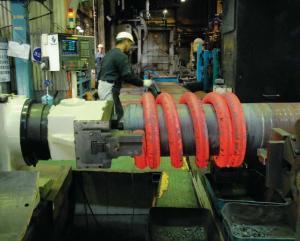 Coiling of the springs at 900°C
Coiling of the springs at 900°C
Watanabe stresses that when a large company asks for a mass production of springs, Tokaibane are not interested and give the potential customers to other mass production spring companies, as staying ahead in the niche market is where Tokaibane feel the most comfortable. Their different approach has earned them the title as the number one producers from energy companies such as Mitsubishi, Toshiba and Hitachi. They have the top share in nuclear power plants and industrial machinery centers, taking orders for specialist springs that are required to have a 40 year guarantee and can withstand heats of 262°C. These companies also ask for complete traceability of their springs— Tokaibane’s springs are tracked from the purchase of the metal to the passing of the spring safety standard tests. However, some of their most interesting orders have come from individuals who have requested springs for antique lighters, clocks, Ferraris and even the world’s highest elevator in Taiwan.
They have even taken orders from an old couple who ran a laundry business. When a washing machine broke and they were in need of a new spring, they looked online and ended up on Tokaibane’s webpage. They then ordered the one spring they were after and were quickly able to resume their business again.
Based in Osaka, Tokaibane have been going since 1934 and for 66 years, have not once recorded a loss. The founder of the company, Nitsuo Minamidani, came from a very poor family of eight siblings. Not expecting to be fed by his family, upon completing primary school, he left his hometown of Gifu Prefecture for the bustling city of Osaka. There, he spent years as an apprentice for various companies and realized that spring manufacturing would be a business with a potential to expand and thrive due to the growth in machine products. Having already established the company in 1934 during the war, the industry as a whole underwent a period of growth and he found the competition of the booming spring industry a challenge. Just a small part of a huge business, he became conscious of the need to be different from the competition and created Tokaibane’s niche. While other companies were mass producing springs, Tokaibane, with their dedicated craftsmen who enjoyed the difficulty of making complex and precise springs, specialized in hand crafted single items and built a reputation as a company that could be relied upon to produce superior quality custom-made products such as the central springs of turbine generators in nuclear power plants.
Today, Tokaibane has over 70 employees and an 80% share of the Japanese market, the unique course it took in the ’40s having paid off with the company serving big name manufacturers among its 1,000 clients. The factory in Osaka is relatively small but highly productive and the demands on the craftsmen are high. A tour of the factory reveals workers hammering red hot 900°C springs into shape, dunking hot coils into oil, as well as the computer calculating targets, controlling temperatures and coordinating rest. There is also a testing center where springs are beaten and battered to check that they comply with the most rigorous of international standards. This has led them to push forward the mark for spring standards by developing and improving their products. For instance, they have spent years improving on the coil spring. Coil springs, when under suspension, have the tendency to bend sideways, creating problems with the thrust. To enable the thrust to be a straight up-anddown mechanism, Tokaibane have developed a coil spring that doesn’t misalign, meaning a more accurate movement and fewer anomalies.
According to JETRO, Tokaibane are the number one manufacturer of the iMC spring—or disk spring as they are more commonly known. Disk springs are disk shaped pieces of metal that have a slight cone shape and are most often used in hydraulic systems and machine tools. Japanese machine tools are number one in the world for rotation speed and many disk springs struggle to keep up with the pace. The iMC spring is different to normal disk springs as when compressed, due to the slight curved angle to which they are manufactured, the disks stay in an almost perfect circumference. Other springs struggle to stay round under pressure and often “sweat” due to the heating-up and then cooling down of the metal, meaning they are prone to rust. IMC springs have been developed to handle the pressure they are placed under when used for high speed cutting tools and thus, are more resistant to the rigorous movements of the edged blades in the tools.
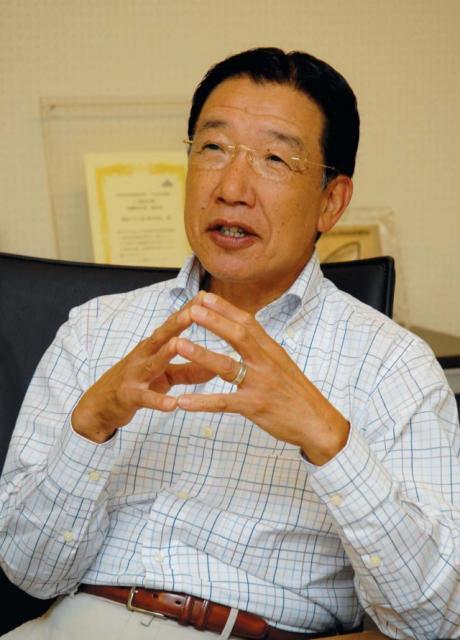 President Yoshiki Watanabe -- Photography by Hiromi Iguchi
President Yoshiki Watanabe -- Photography by Hiromi Iguchi
The cutting edge
Tokaibane’s focus on research and development has largely taken place since Yoshiki Watanabe, the new president, took over from the founder over 20 years ago. Like the founder, Watanabe also has a unique story about his entry into the company. The founder had three daughters, all of whom married. However, upon calling out to the husbands to take over the position of president, they all declined, leaving the problem of who would take over the company. Looking around, one of the husband’s younger brothers caught the founder’s eye. Spring manufacturing is not a glamorous job and being young and bull-headed, Watanabe at first refused the offer. Fortunately for Tokaibane, Watanabe’s family pleaded with him to take over and he has now made his mark on the company by providing constant innovation, development and improvement. Although at first reluctant to go into the industry, he quickly developed an understanding of the spring manufacturing industry and a passion to drive the company forwards. One of the most profound improvements made to the company infrastructure has been to introduce an IT department to cope with the huge selection of springs on offer. Tokaibane started using computers 30 years ago—a Mitsubishi ‘Melcom80’—as a data-bank for all orders made to the company. As a single item production company, many customers would order a certain tailormade spring and then call back, often 15, 20, 30 years later, asking for the exact same spring again. The data-bank means that all the necessary information is found instantly and the exact same order can be easily processed.
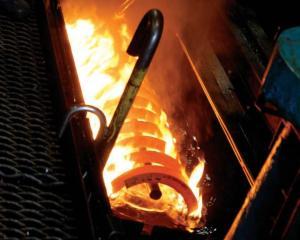 Dunking the red hot metal into oil
Dunking the red hot metal into oil
Tokaibane’s constant innovation has won the company recognition. They have received awards for their IT services including the Kansai practical IT application awards three years running. They also realized that to reach the rest of the world, they would have to put more energy into their homepage and make it customer friendly by adding an edictionary for any spring-related queries. Orders can now easily be made online, cutting out the problem customers may face when deciding which springs they require and which company to use.
The benefits of their innovative use of IT can be found in numbers—1,000 new companies were added to their client list last year, totaling in at 30,000 orders. But Watanabe expresses that they are still an order-made company: “The average size of orders from each client is still just five pieces or less, meaning each unit price amounts to as little as ¥50,000.”
Although other companies shy away from such difficult and complex orders (in a mass production market, it simply isn’t worth it on the bottomline) Tokaibane’s strength lies in their ability to produce products that require special care and attention. Their different approach to doing business has resulted in them being used as a business model for the Graduate school of International Corporate Strategy at Hitotsubashi University.
Although they have already accomplished plenty with their IT development, Watanabe is keen to still improve further: “It’s not that we want to improve our IT in order to make money quickly, we want to improve it so we can carry on making complicated pieces and support our craftsmen.” In the future, the company plans to increase overseas sales by gearing up for 24 hour production at their Toyooka plant and establishing a system to deal with English. Other improvements include developing their tools to support the workers who, given the difficulty of the job, are happy for the support they receive, be it human or machine—but his main requirements are that his craftsmen have a desire to work and improve on their skills. “Our workers are determined. Once in the company, they constantly take tests and qualifications to become master craftsmen.” Their employees take great pride in the fact that they can create springs that no other spring manufacturer can do—a credit to Watanabe who supports their strengths and encourages his craftsmen to push themselves further.
Although war has acted as a spur for innovations and stimulated growth, Tokaibane have expanded predominantly in the postwar era. Clearly peace has been beneficial to their prosperity but Watanabe prefers to give credit to the uniqueness of their product and the company’s will to succeed: “We walk on a different path to other spring manufacturers, and through the need to survive, have in our DNA a constant desire to improve.”JI
Contact details
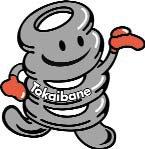
Tokaibane Mfg Co Ltd
President: Yoshiki Watanabe
3-7-27 Sagisu,
Fukushima-ku,
Osaka, 553-0002
Tel: +81-6-6453-3120
Fax: +81-6-6453-6181
Email: tokai-info@tokaiweb.net
Web: www.tokaibane.com
J@pan Inc Magazine, Nov/Dec 2007





